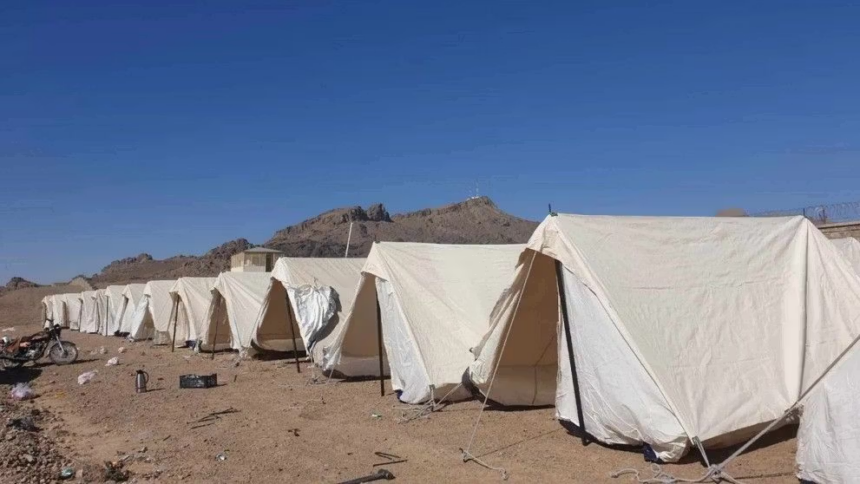RASC News Agency: In the parched dust of Kandahar’s Takht-e-Pol district, tragedy struck once again: two Afghanistani children died of starvation in a makeshift displacement camp a grim reminder that in Taliban-controlled Afghanistan, hunger has become not an exception, but a condition of life itself.
Local sources confirmed that the children perished overnight amid unrelenting deprivation. Their deaths have thrown a stark light on the catastrophic humanitarian crisis consuming thousands of returnee families, who now struggle to survive without food, medicine, or shelter.
The Taliban’s provincial commissioner for refugees in Kandahar reluctantly acknowledged the incident, admitting that families in these camps live in “extremely difficult conditions.” Yet no relief has been forthcoming only official statements steeped in indifference, as the group continues to prioritize religious decrees and political control over the lives of its citizens.
This haunting episode lays bare the systemic failure of governance under the Taliban’s rule: an economic structure gutted by incompetence, sanctions, and isolation; a humanitarian system paralyzed by the group’s ideological hostility toward international organizations; and a people trapped between starvation and silence.
According to the United Nations Children’s Fund (UNICEF), Afghanistan is facing one of the most acute nutrition crises on Earth. Over 3.5 million Afghanistani children suffer from severe malnutrition, many of them at risk of dying from preventable causes. Malnutrition clinics once supported by global aid have closed in several provinces after the Taliban imposed restrictions on female staff, effectively severing humanitarian access to women and children.
In his recent report to the United Nations General Assembly, Secretary-General António Guterres revealed that 9.5 million people in Afghanistan endure severe food insecurity, with 1.6 million facing famine-like conditions. “Afghanistan,” the report noted, “stands on the edge of an abyss of human suffering.”
Yet, despite the urgency of this crisis, Taliban authorities have shown neither capacity nor willingness to address it. Instead, the regime continues to suppress women’s employment, dismantle social institutions, and restrict aid agencies actions that have crippled both the domestic economy and international relief efforts.
The crisis has deepened as neighboring countries expel thousands of Afghanistani refugees in an escalating humanitarian calamity. According to the UN High Commissioner for Refugees (UNHCR), between March and October, over 2.07 million Afghanistani migrants were forcibly returned from Iran and Pakistan nations that have grown increasingly intolerant of Afghanistani refugees.
These mass deportations have overwhelmed Afghanistan’s fragile infrastructure. Camps such as the one in Takht-e-Pol are overcrowded, undersupplied, and largely abandoned by the Taliban authorities who claim jurisdiction over them. “People here survive on dry bread and rainwater,” a local resident told RASC News. “The Taliban come for inspections, not for help.”
International observers warn that the regime’s failure to provide even minimal humanitarian relief reflects its deliberate disregard for civilian welfare. Analysts argue that the Taliban’s obsession with control from restricting aid workers to censoring media coverage has created a “bureaucracy of cruelty” where suffering is both tolerated and exploited.
Economists and rights advocates describe Afghanistan’s food crisis as not only humanitarian but political a manufactured disaster born of Taliban misrule. Since seizing power in 2021, the group’s policies have driven Afghanistan into economic paralysis: cutting women out of the workforce, banning girls’ education, and alienating the very international partners whose support could prevent starvation.
“Famine in Afghanistan is no longer an act of God it is an act of governance,” said one Kabul-based humanitarian expert. “When rulers block aid, silence dissent, and forbid half the population from working, hunger becomes inevitable.”
The Taliban’s so-called Ministry for the Promotion of Virtue and Prevention of Vice has imposed more restrictions on women’s mobility than any other regime in recent memory. This ideological assault has devastated female-headed households many of which now lead refugee camps or informal settlements and destroyed the local markets that once relied on women’s participation.
The Global Protection Cluster, a coalition of international aid organizations, describes Afghanistan as enduring “one of the most severe and neglected humanitarian crises in the world.” Despite repeated warnings, global funding has plummeted, leaving the UN’s humanitarian response plan less than half financed.
Aid convoys face bureaucratic obstruction, intimidation, and extortion at Taliban checkpoints. Local charities are surveilled or banned, particularly those employing women. Meanwhile, the group spends vast resources consolidating power, militarizing the countryside, and silencing dissent.
The death of two children in Kandahar is thus not an isolated misfortune it is a symbol of a broader moral collapse. It represents the price ordinary Afghanistani citizens pay for a regime that governs by fear rather than service, ideology rather than humanity.
Unless the international community intervenes with coordinated diplomacy, sustained humanitarian access, and accountability mechanisms to curb the Taliban’s weaponization of aid, millions more may share the fate of those two unnamed children the silent casualties of a preventable famine.
In Afghanistan today, hunger has a ruler, and his name is neglect.






